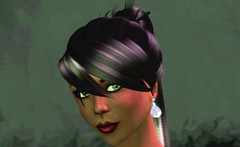Highlights are meant to compliment your hairstyle, and face. They can be any tone or shade you desire; they are lighter than you original hair color. Generally they are placed at the crown and around your face for optimum effect. The thicker the highlights (thick highlights are also known as chunky highlights), the less natural they look. The thinner the better. Want to mix them beautifully? Go for contrast, with highlights that are even, thin and natural looking.

- Image by Torley via Flickr
For a general idea of shades to use, look at the following:
- If you have dark hair, go no more than three shades lighter than your natural color.
- If you have black hair, red highlights enhance the contrast and cut of your hairstyle; blonde or caramel highlights blend well, so they are the most popular highlights; purple highlights soften dark hair color and add subtlety, highlighting your bangs. Feeling quirky and fun, by trying multicolor highlights.
- If you have brown hair, it has shades of red to go through first. If done incorrectly, it will turn brassy. Some shades of platinum blonde are fine on brown hair; do not use platinum blonde on dark brown hair, or it will turn your hair green.
- For light brown hair, try a color two shades lighter than your original hair color; copper highlights look great; try copper and gold highlights for a gorgeous look.
Lowlights are meant to add definition and depth to your hairstyle. Adding lowlights the third time you get your hair highlighted, will blend your highlights with your natural color which looks fabulous and prevents salon trips every six weeks to cover dark roots. Tones of blended copper and gold are often the best lowlights to use. As always, consult your stylist.
Anastasia is a salon hair stylist in Oklahoma City, Oklahoma. Out of town appointments welcome.
2036823d-e846-486f-89bd-216c5ce233e0

what would be the best way to soften the clore of my jet black hair.ive been told that purple higlights would work but unfortunatly that would not be suited for my work place. i currently only use hair dye on a small section of my air where i generally get alot of white hairs.
First, don’t try to soften the jet black to more natural black. The jet black color needs to be removed (using a decolorizer – e.g. Pravana’s decolorizing process). Don’t use box color at all, if that’s what it is – the damage to your hair and scalp (and health) over time, and the poor results are not worth it – it will cost more to repair and rebuild your hair in the end.
Second, once the color is removed, get a professional color job of the correct level (requires an experienced colorist consultation – the consultation in person is often free). The stylist can create a naturally black look. Choose a stylist that uses a highest quality, low ammonia color (if you smell a lot of chemical in the air, it’s not the right stuff).
Keep in mind, even a short commuter flight to a great colorist can be cheaper than a bad color job followed by a strip and recolor. If you’re going to be in this part of the country and want to make an appointment, you could call it a vacation, stay at a bed and breakfast, and get a Friday or Saturday recolor. Call me to book in advance. There are some great areas in Oklahoma City that you might enjoy (Midtown District, Western Ave District, Paseo District, Bricktown). You can get a pedicure, manicure, massage while you’re in the city.
On average, how much do you charge to correct color mistakes?
Hi Linda, please give Anastasia a call to discuss your color correction needs. 🙂